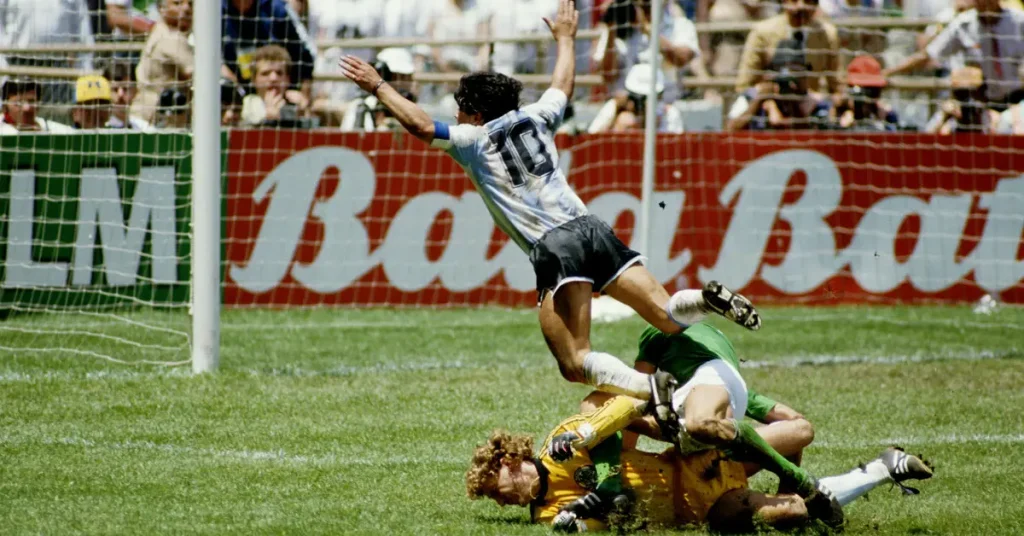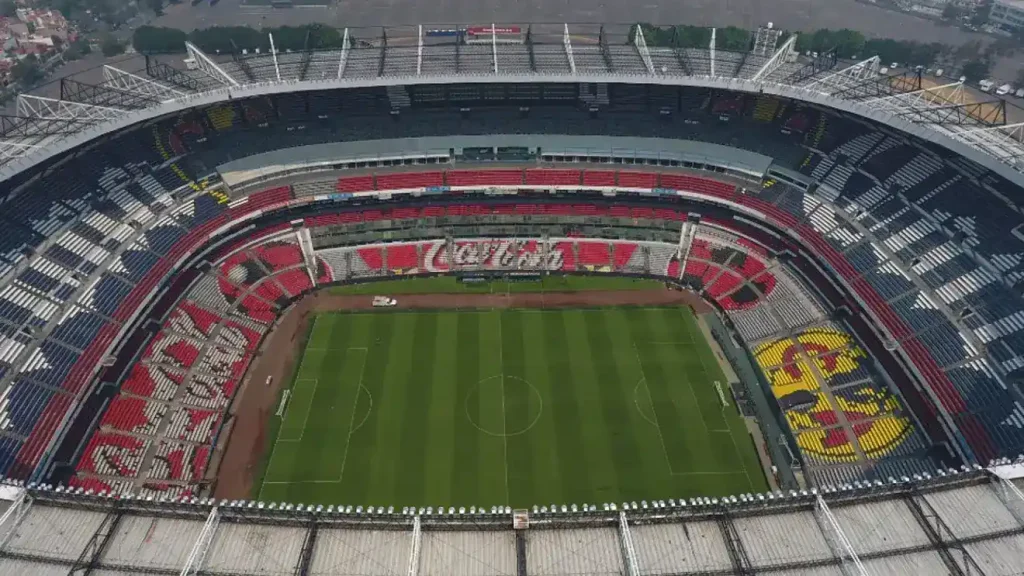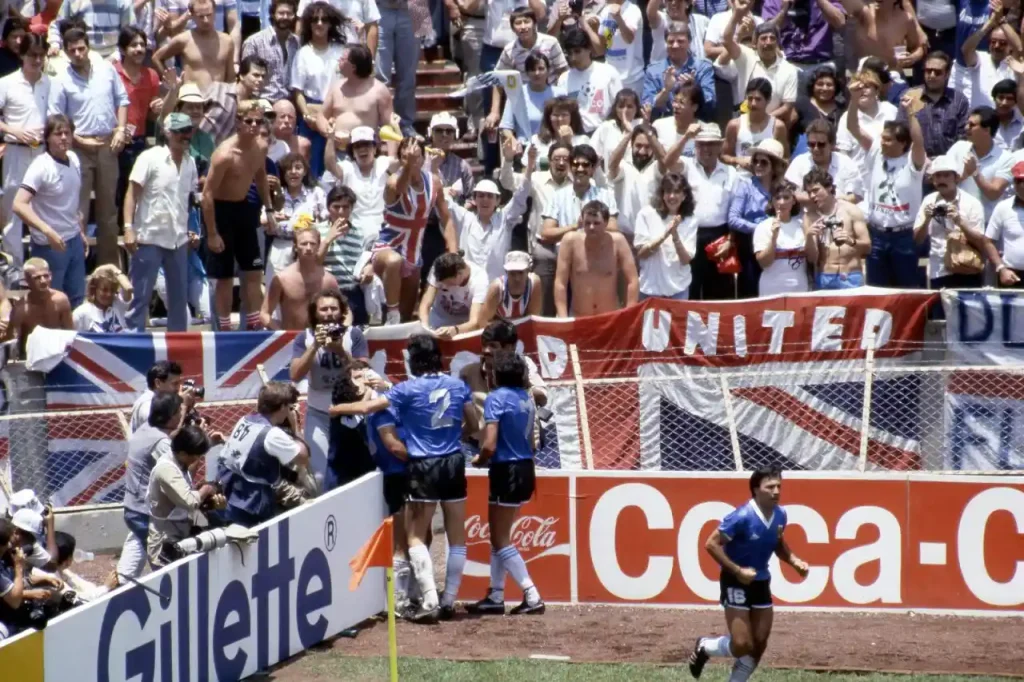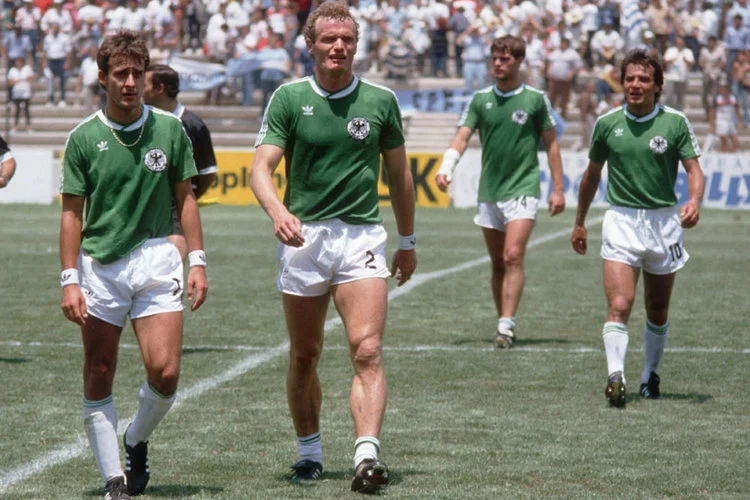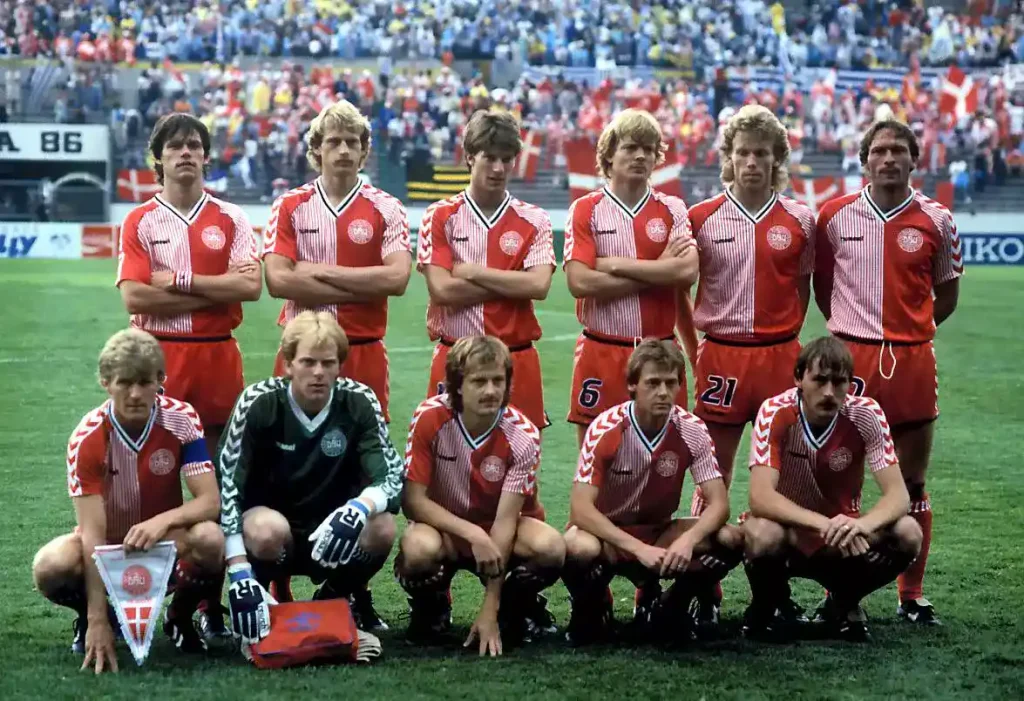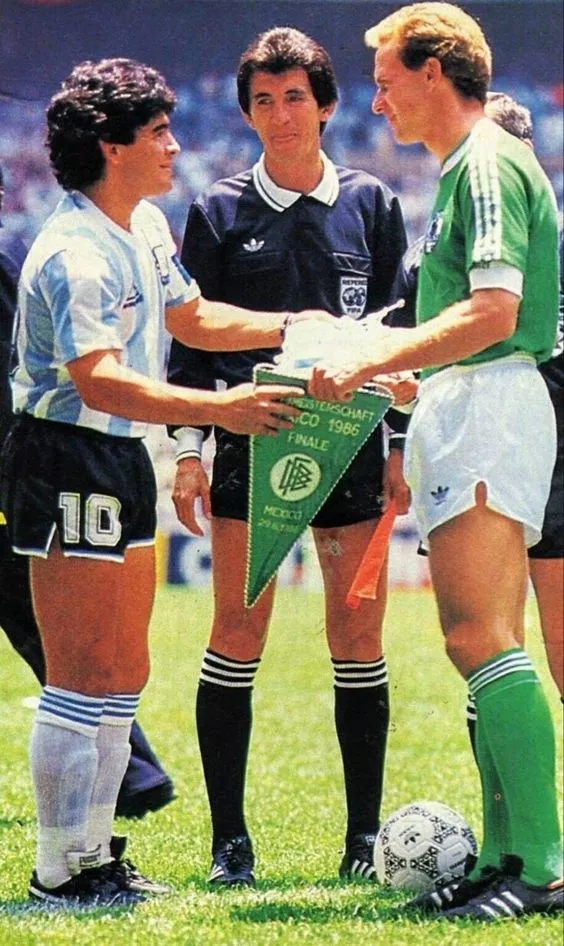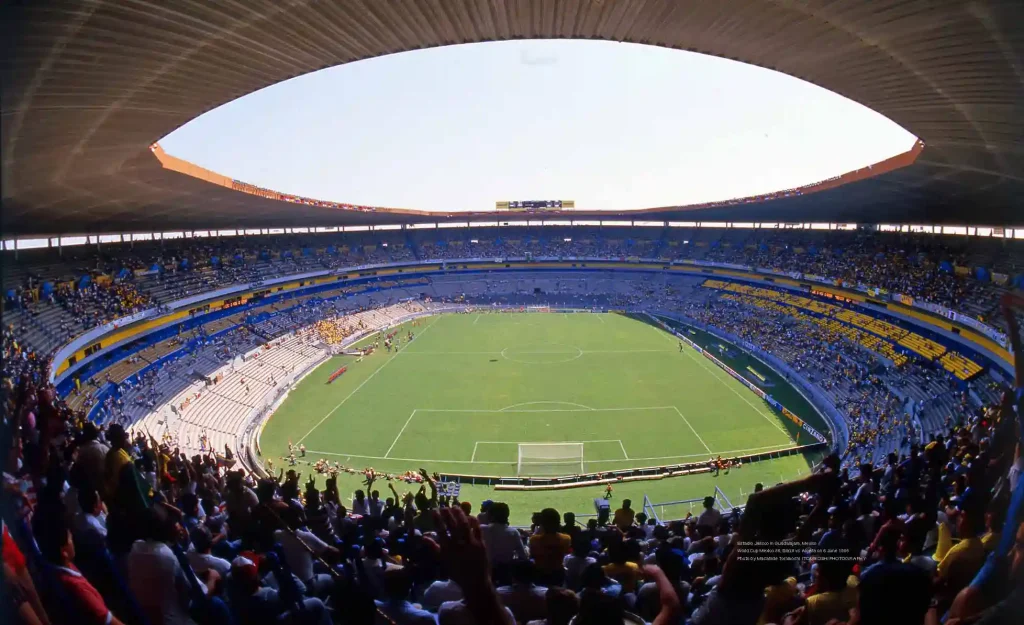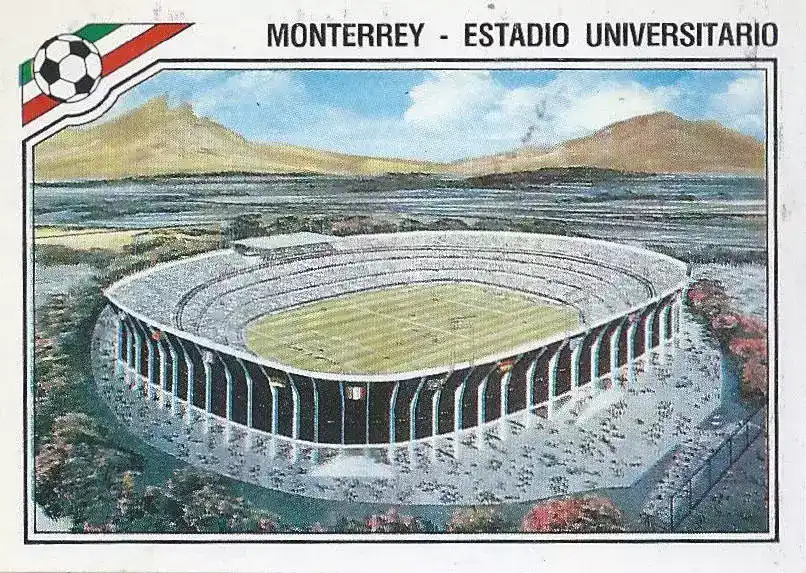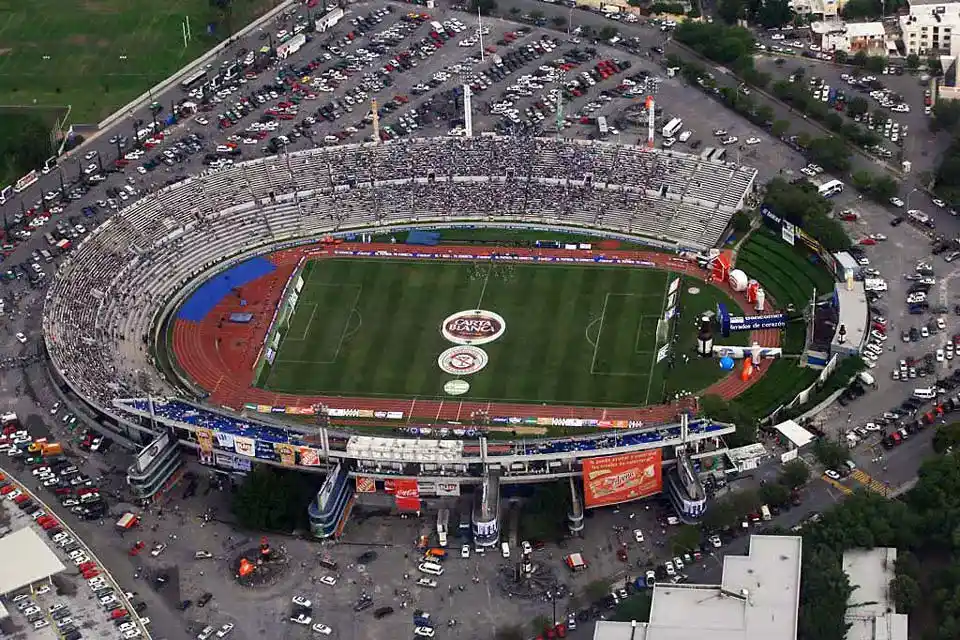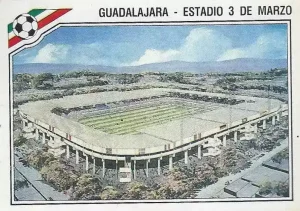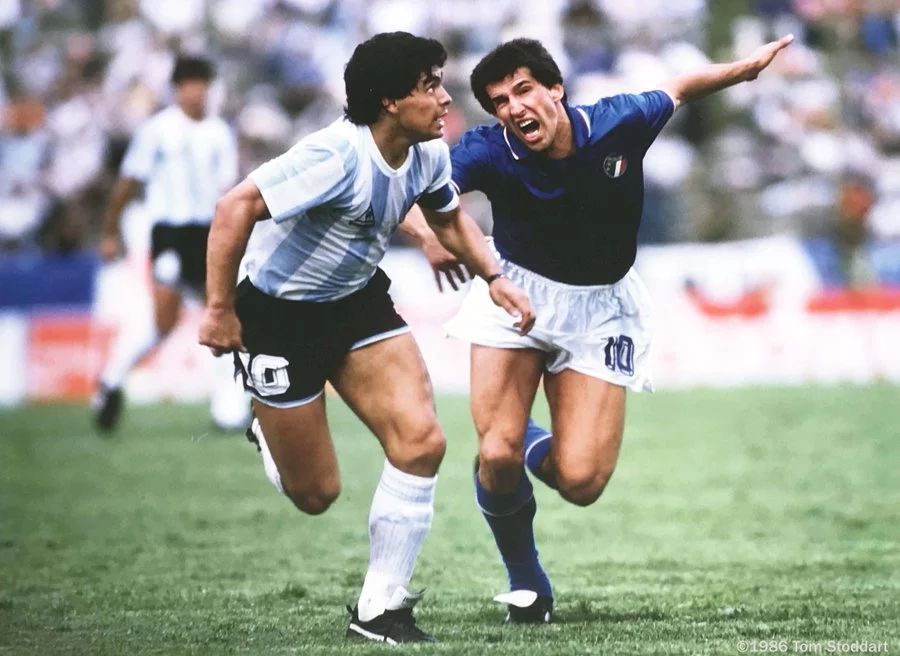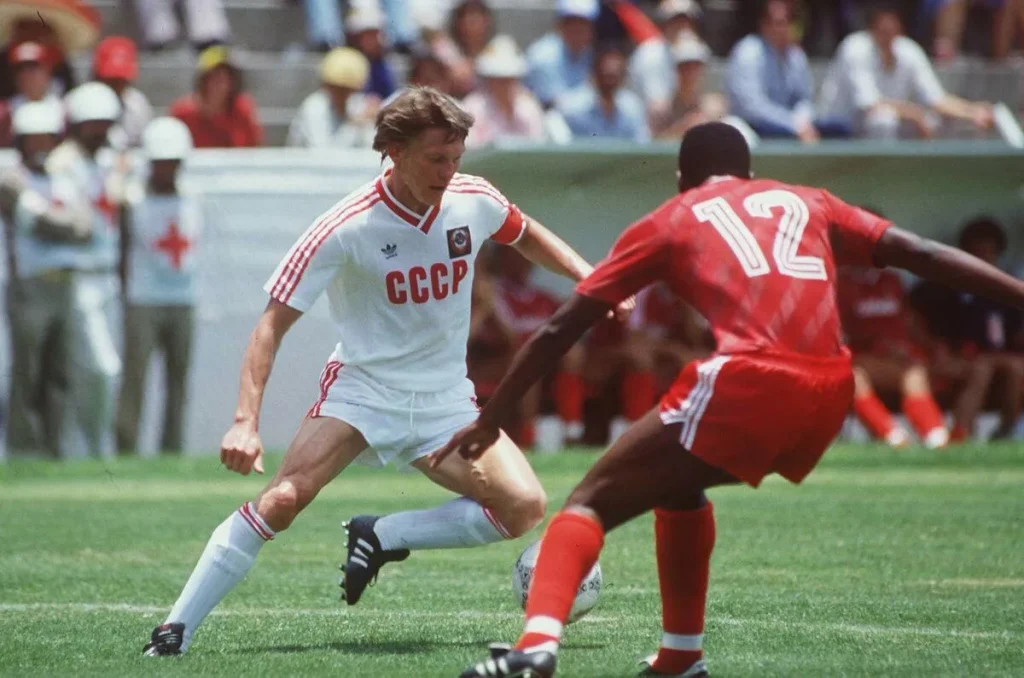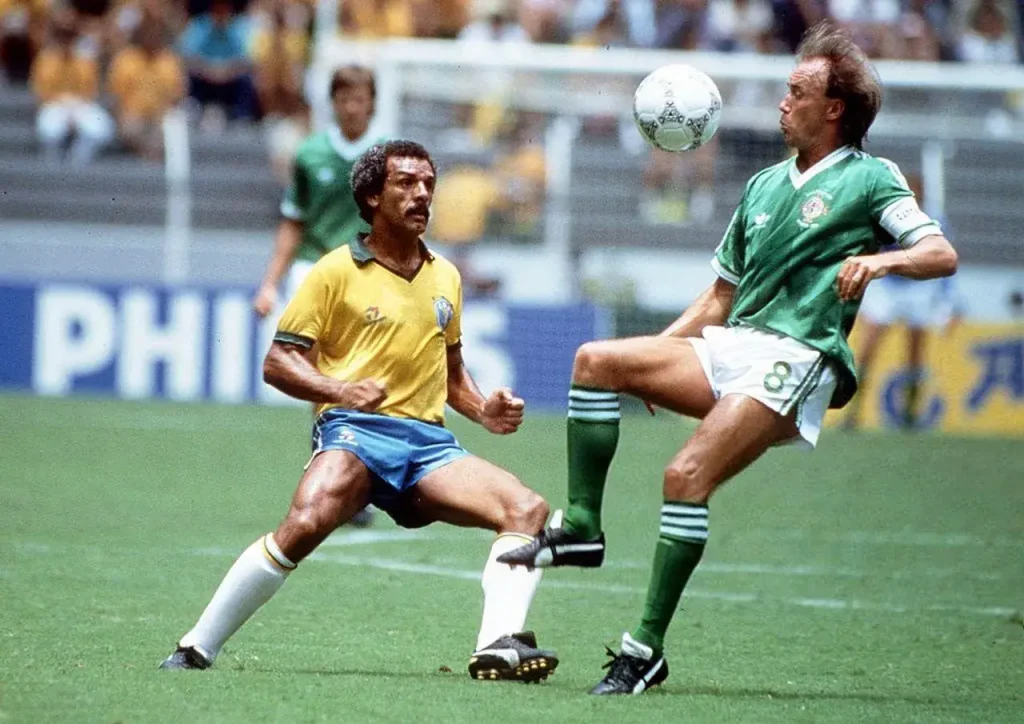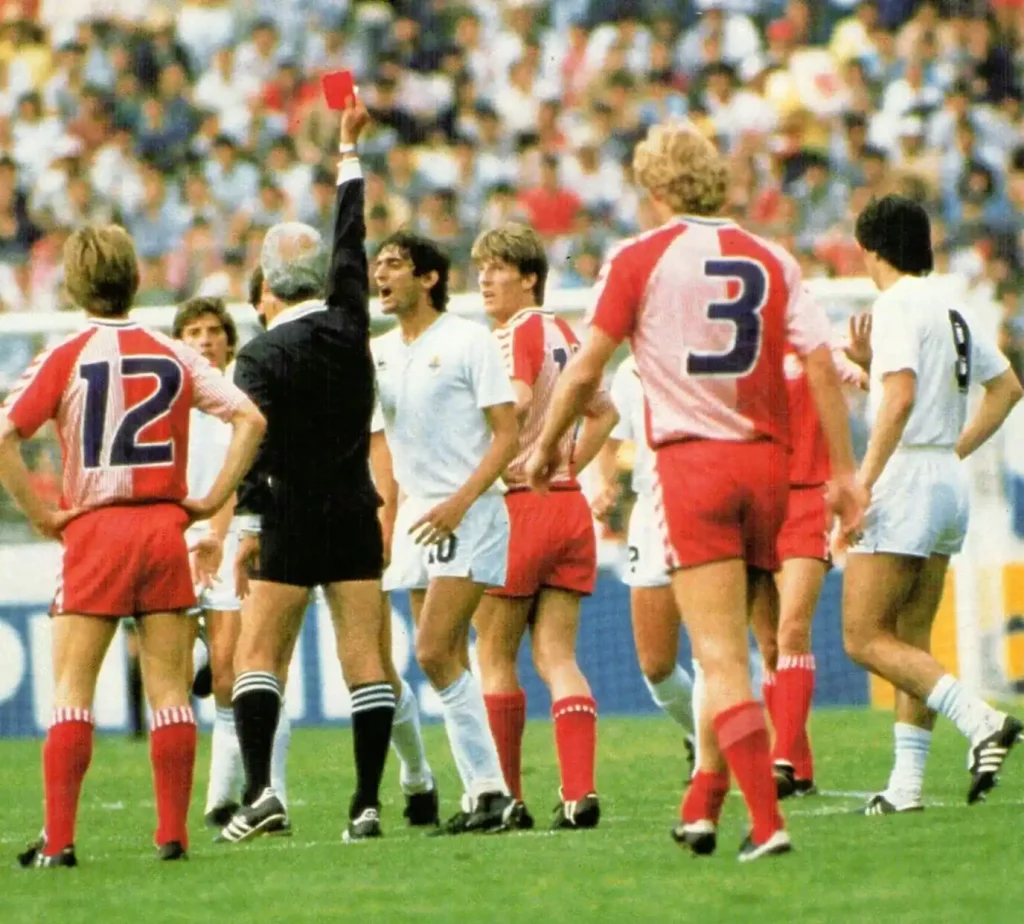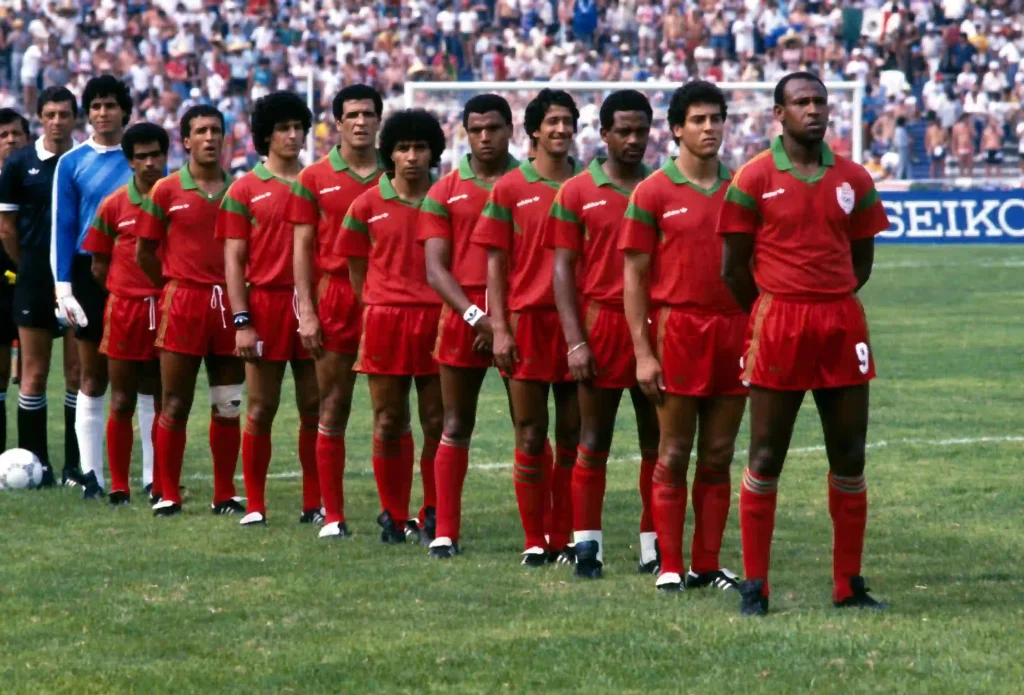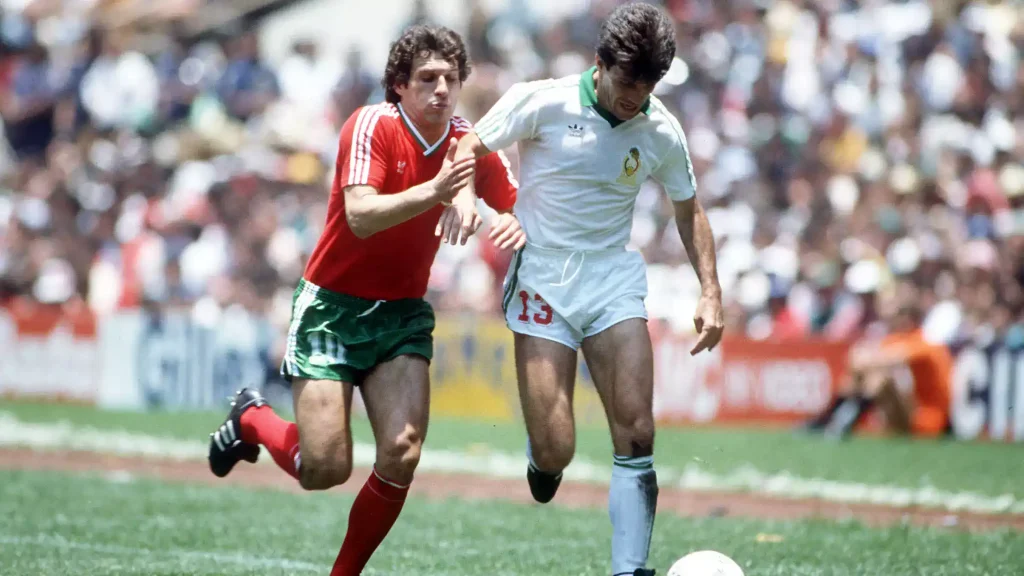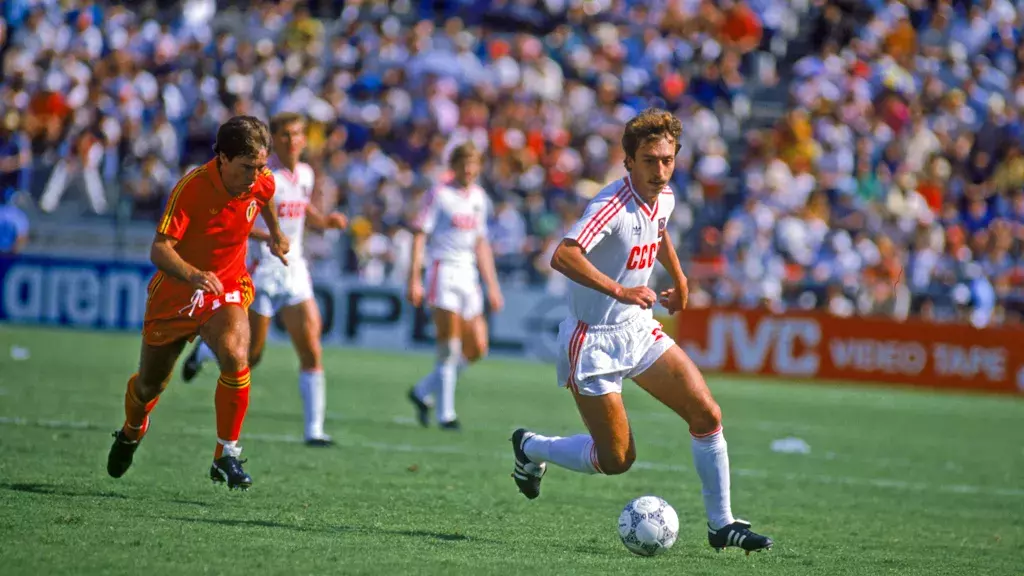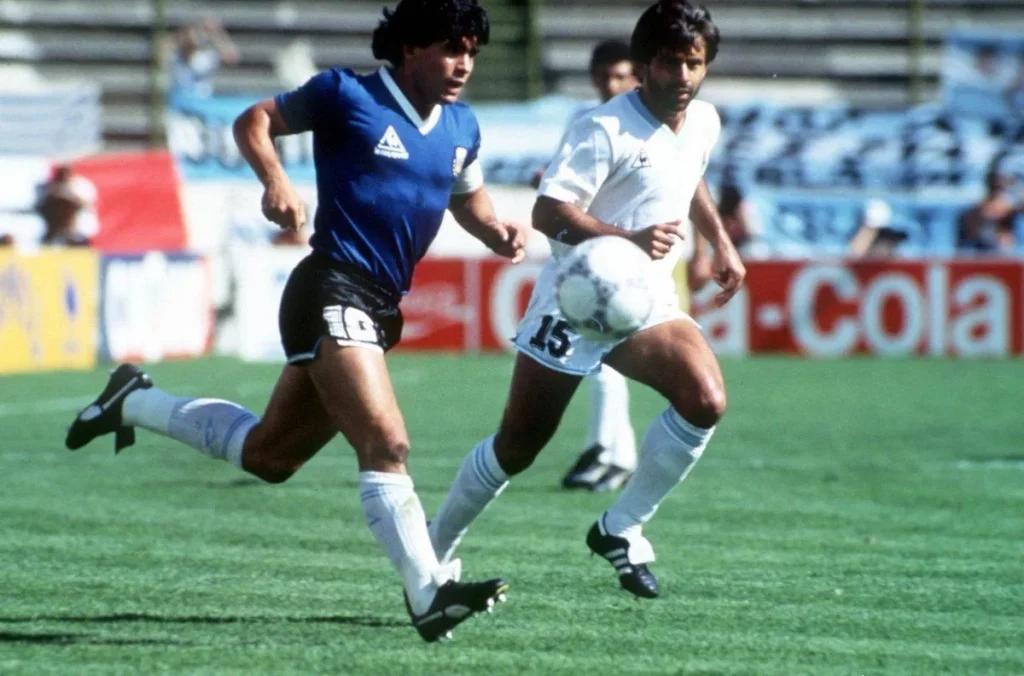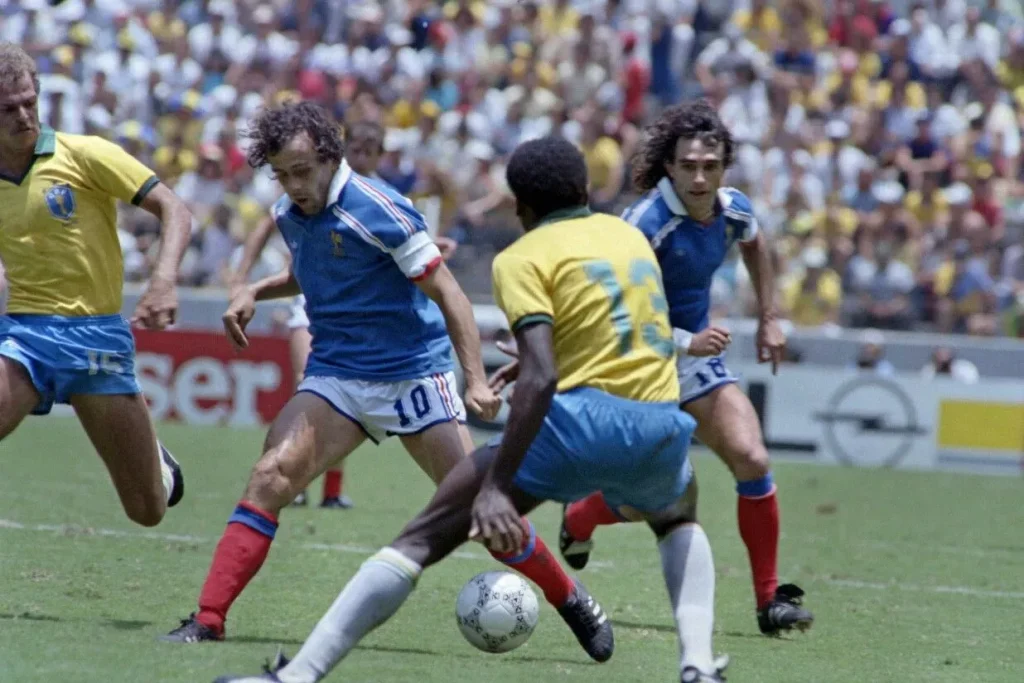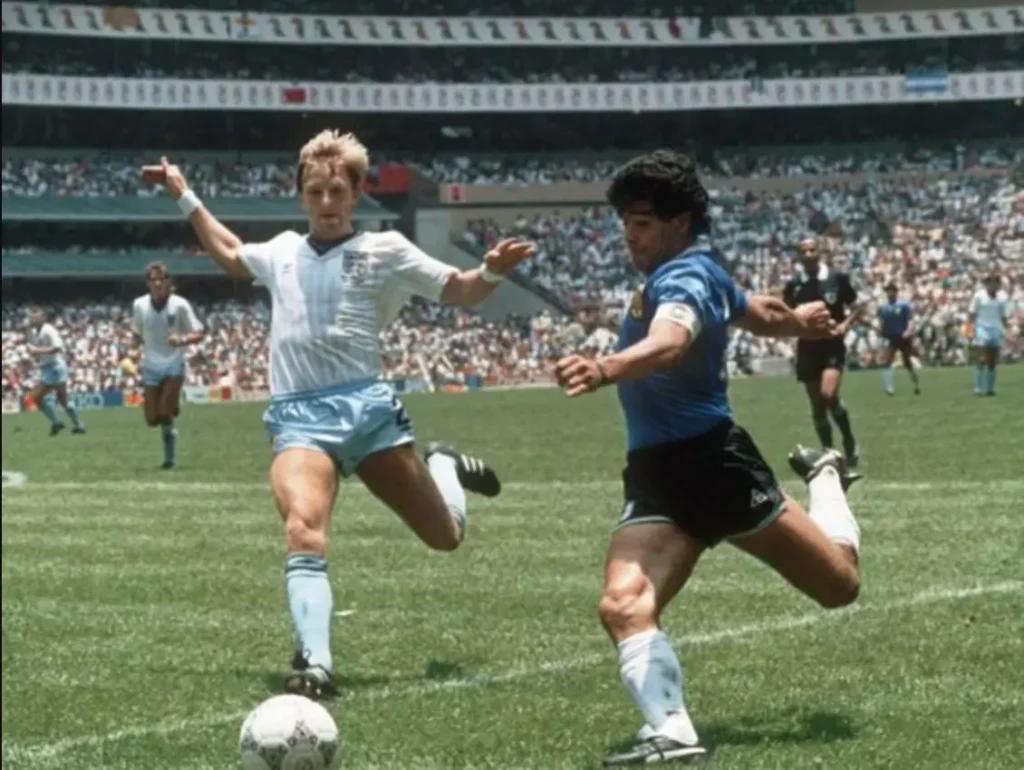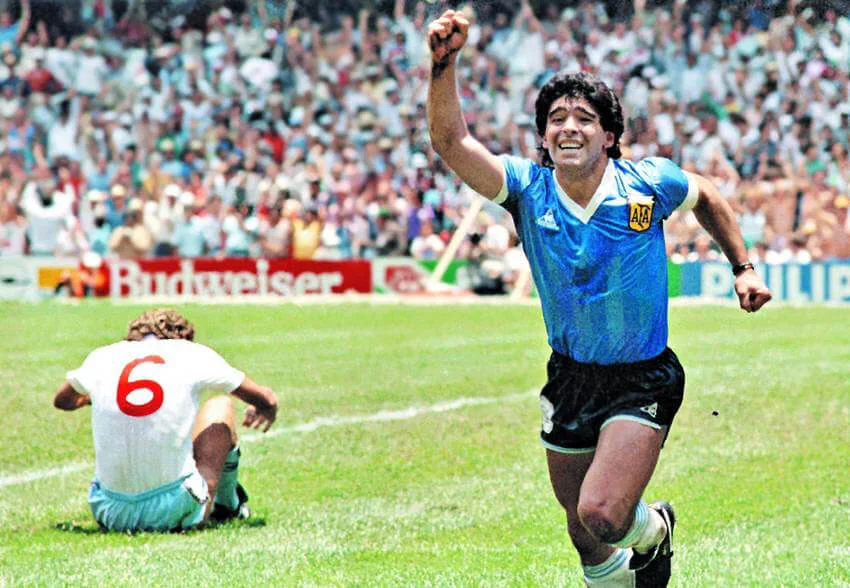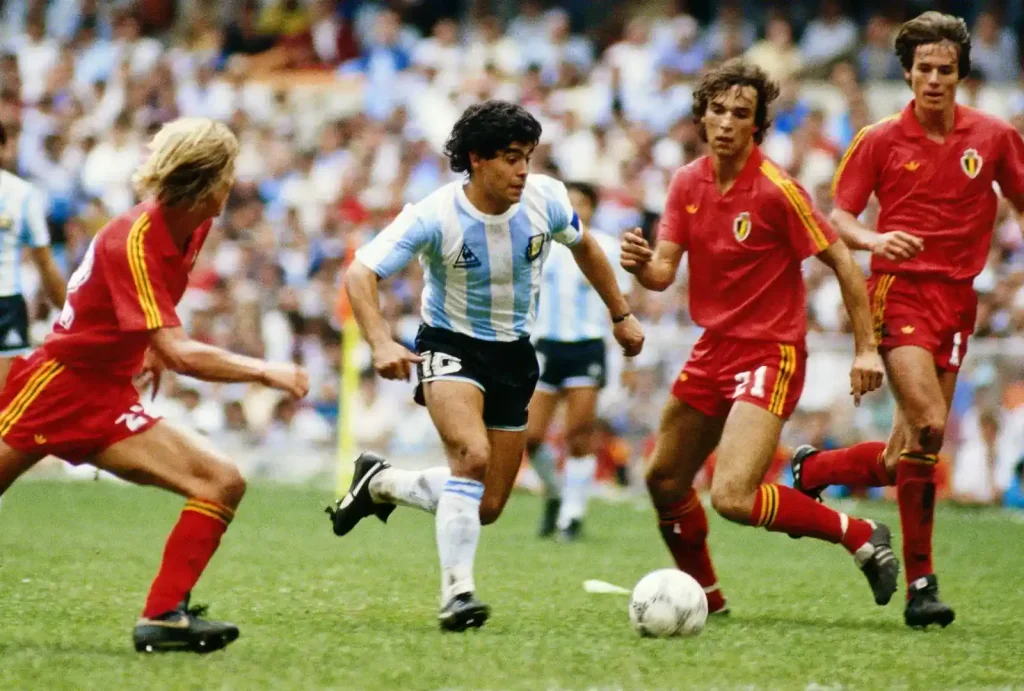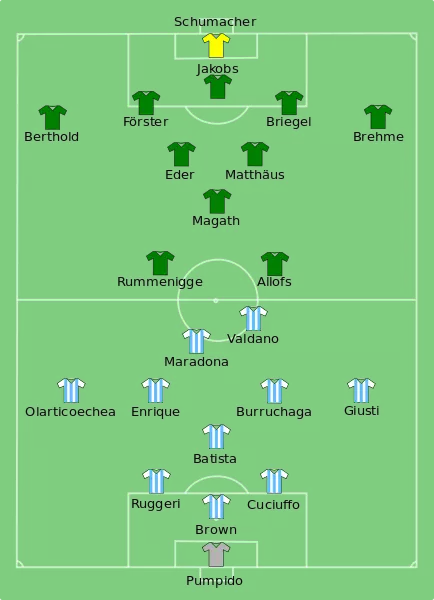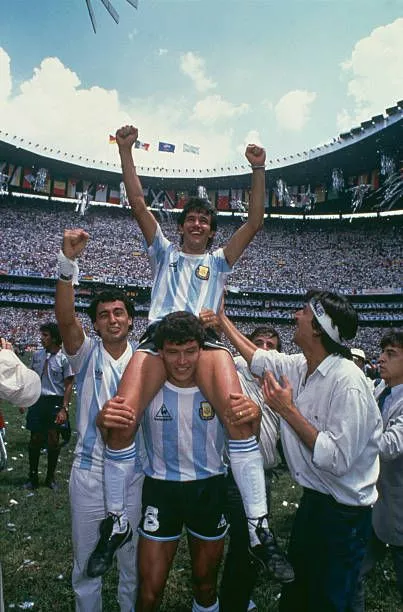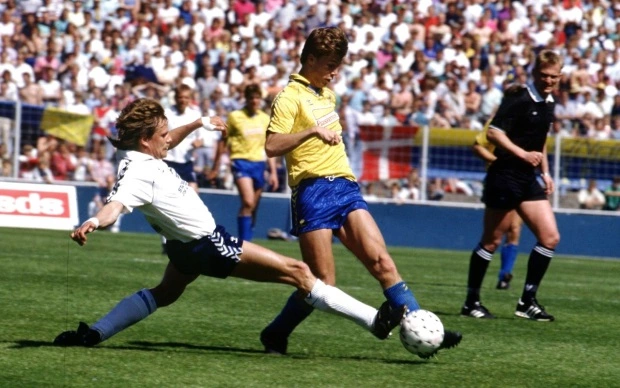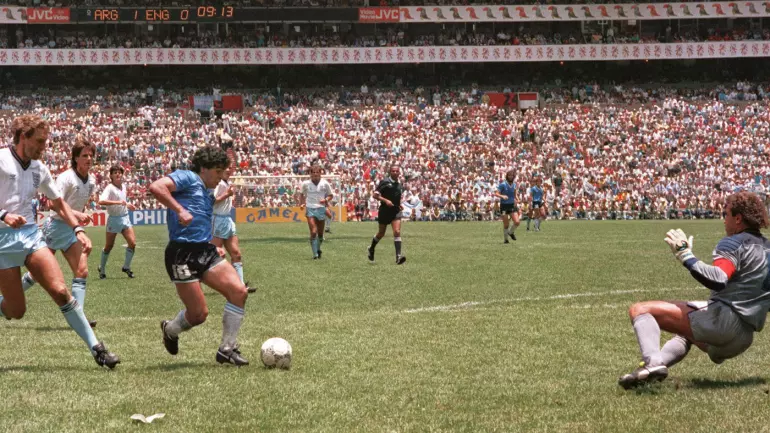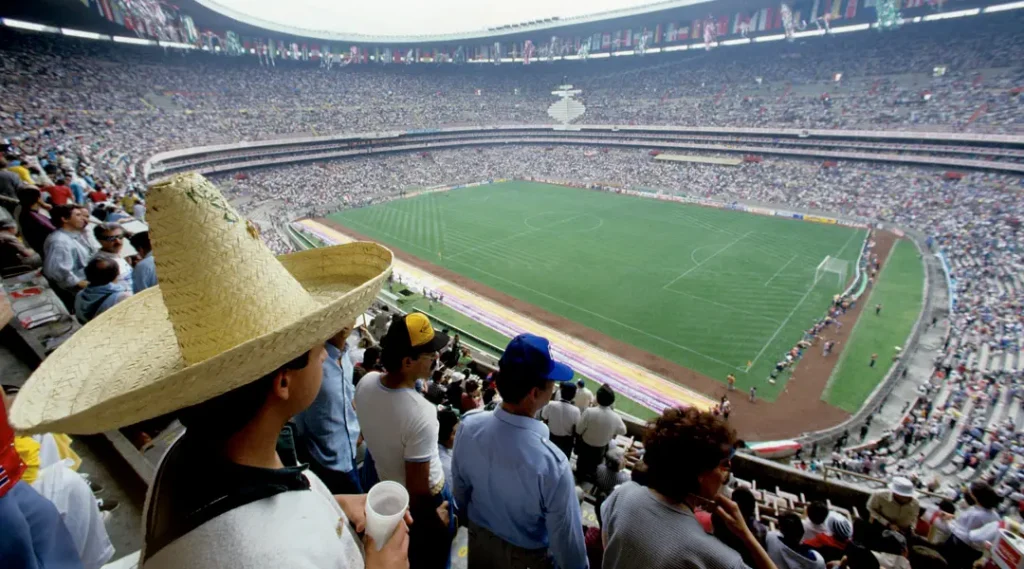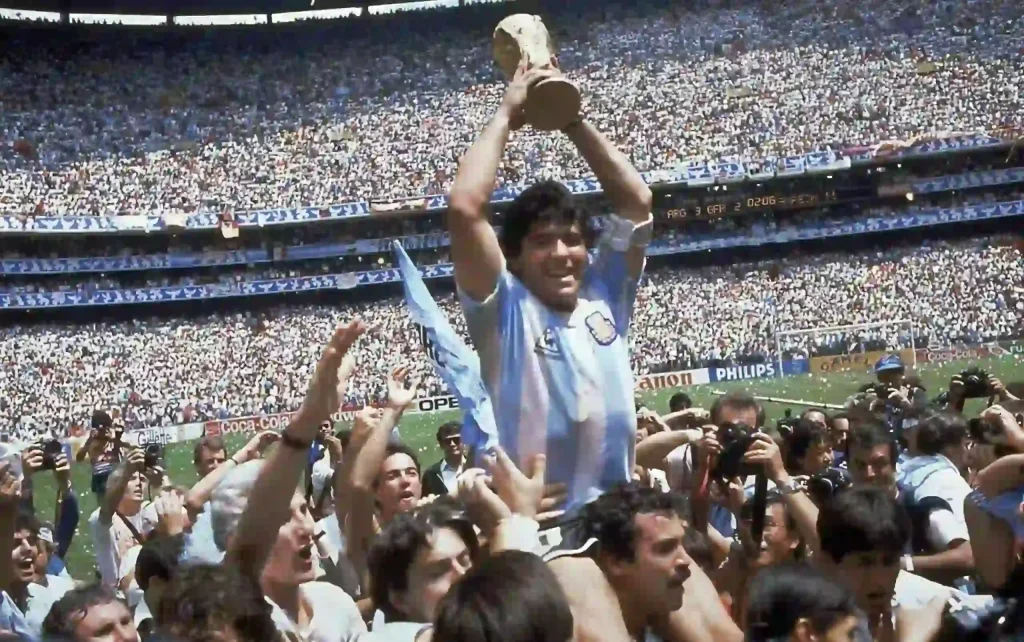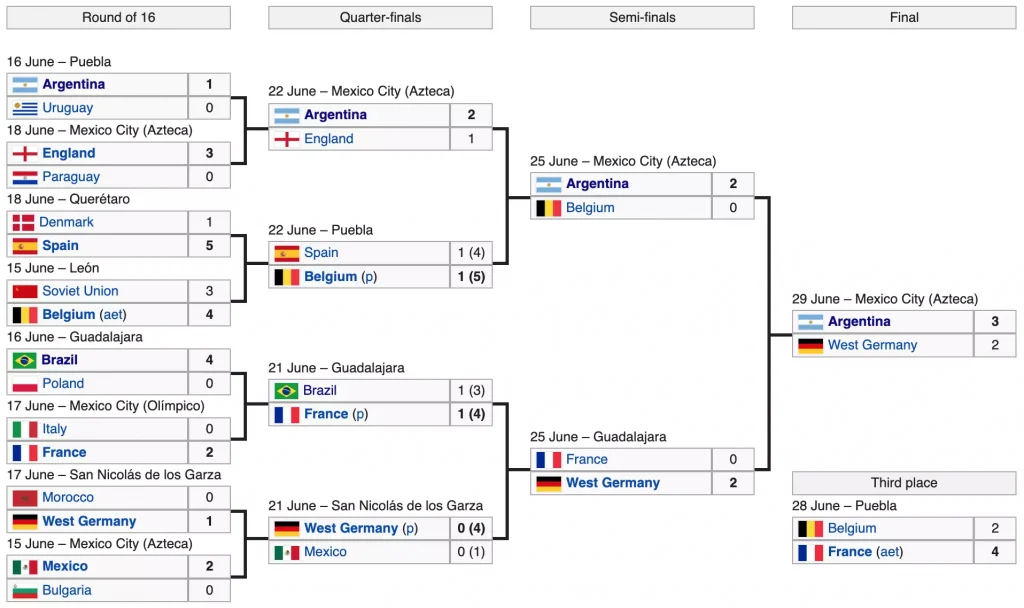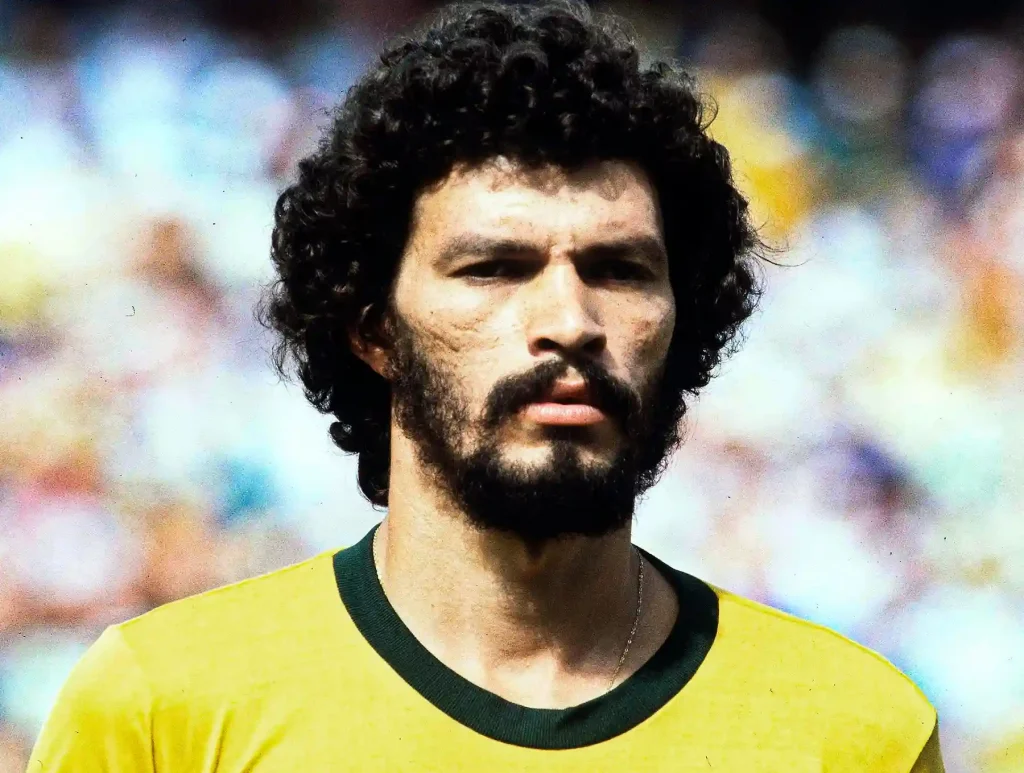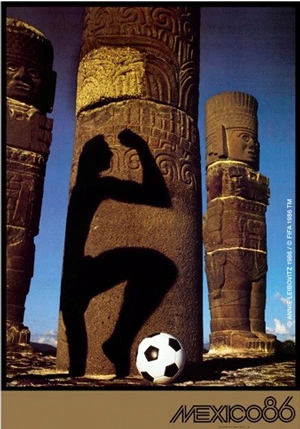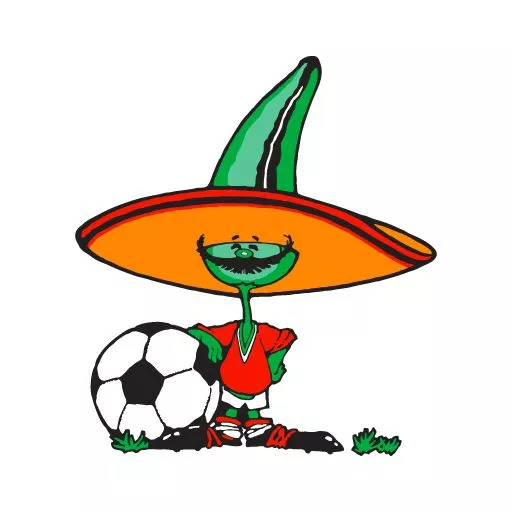The 1986 World Cup saw the rise of another football immortal. Until that year, Diego Armando Maradona was only an excellent Argentine midfielder with rare skill, a track record of indiscipline, and a controversial figure.
However, after June 1986 in Mexico, Dieguito became a myth. For everyone, a genius with his left leg; for many, comparable even to Pele; for the Argentinians, a demigod.
1986 World Cup Facts
Dates: May 31 – June 29, 1986
1982 World Cup Final Score: Argentina – West Germany 3-2
3rd place: France – Belgium 4-2
Teams: 24
Stadiums: 12
Host cities: Eleven cities
Matches played: 52
Goals: 132
Attendance: 2,393,031
Top scorer: Gary Lineker (England) 6 goals
1986 World Cup Background
For the 13th edition, Colombia was the only South American to place a bid. Host voting was from this FIFA World Cup only handled by the FIFA Executive Committee (Exco) instead of the FIFA congress.
On June 9, 1974, in Stockholm, they announced that Colombia would host the 1986 World Cup. However, in November 1982, 4 years before the tournament would start, Colombia withdrew their bid! They stated the country’s financial problems was the main issue. As a reaction, countries were able again to place a bid to host the 1986 World Cup.
Canada, the United States, and Mexico showed interest and officially placed a bid. On May 20, 1983, the Exco voted unanimously for Mexico, which was allowed to host the 1986 FIFA World Cup for the second time.
Their first World Championship was hosted in 1970. Mexico became the first country in history to have hosted a World Cup twice. This was the first time the host country announcement was made from Zurich, Switzerland.
From this announcement, all the votes regarding the WC host countries would be announced in Zurich, where the FIFA headquarters are based. On September 19, 1985, eight months before the tournament, a severe earthquake occurred in Mexico City, creating immense damage in several cities.
This event created doubt about whether Mexico could continue with the preparations, as was the case with Chile, the host country of the 1962 World Cup. However, the stadiums were not damaged, and Mexico could still proceed with the preparations and finish on time.
The year 1986 was declared the International Year of Peace by the United Nations. There was a clear emphasis on this declaration since the stadium’s advertising boards showed both the FIFA and United Nations logos, including the slogan: Football for Peace – Peace Year.
The logo of the 1986 World Cup received the following unofficial motto or slogan referring to the design of the logo: El Mundo Unido por Un Balón (The World United by a Ball). This slogan could be considered the first ever FIFA World Cup slogan.
World Cup 1986 Participants
As with every new World Championships, more countries tried to qualify. For the 1986 World Cup, 121 countries participated in the qualifications, trying to be 1 of the 24 countries that eventually would participate in the tournament.
As was introduced in the 1982 FIFA World Cup, Mexico ’86 would consist of 24 countries. Mexico (host country) and Italy (defending champions) were automatically qualified.
Twelve European places were allocated to the following countries: Bulgaria, Belgium, the Soviet Union, France, Hungary, Spain, Northern Ireland, Denmark, West Germany, England, Poland, and Portugal. Denmark qualified for the first time, and Portugal qualified for the first time since 1966.
Four places for South America were allocated to the following countries: Argentina, Brazil, Uruguay, and Paraguay, which qualified for the first time since 1958. Two places for Africa were allocated to the following countries: Algeria and Morocco.
Two places for Asia were allocated to the following countries: South Korea and Iraq. As a result, Iraq qualified for the first time, and South Korea qualified for the first time since 1954. One place for North/Central America and the Caribbean. Canada qualified for the first time.
One intercontinental play-off had to be played by two countries that didn’t qualify directly: UEFA country Scotland against OFC country Australia. Scotland won the play-off and qualified last minute for the 1986 World Cup.
1986 World Cup Draw
A striking Mayan decor accompanied the draw at Televisa’s Mexico City studios. During an intense 23 minutes, 45 draw procedures were performed, with three young boys proficiently picking up plastic balls.
Mexico, Italy, Brazil, Germany FR, France, and Poland were seeded in the six first-round groups following the switch from three-team groups to a knockout round in the second round.
World Cup 1986 Groups
Although Mexico ’86 contained 24 teams, the format introduced new features like in Spain ’82. The round-robin 2nd Round, introduced in the 1974 FIFA World Cup, has been replaced with a different format.
It is the Round of 16 that makes its introduction in this World Cup. This is the start of the knockout phase, meaning if you lose, you’re out. The six groups are now mentioned as Group A, B, etc., instead of group 1, 2, etc.
Each group contains four teams, where the two best teams advance to the Round of 16. The second interesting aspect of the format is that the last 2 group matches would be played simultaneously for the first time in history.
In both the 1978 and 1982 FIFA World Cups, the last group matches were affected due to the result of the other group match previously played. (Remember Argentina against Peru in 1978? Or West Germany against Austria in 1982?).
Therefore, by introducing this rule, all four teams will give their best in the last group matches since it is uncertain yet what the outcome of the other game will be. The last group matches have become more exciting with this rule.
The third new aspect of the 1986 format is that aside from the number 1 and 2 teams, the four best third-place teams would advance to the Round of 16 Only two teams occupying third place would not advance from the six groups. The goal difference rule would be implemented if multiple third-place teams had equal points.
If the goal difference were the same, the number of goals scored would have to determine the position of both countries. Lots had to be drawn only when this amount was the same.
In the Round of 16, the number 1 teams of the groups would play against the number 2 or 3 teams of other groups. Although some Round of 16 matches contained number 2 teams against another number 2 team, they would not play against number 3.
After the Round of 16, the winning team advanced to the Quarter-Finals. The last time the Quarter-Finals stage was played was back in Mexico in 1970. After the Quarter-Finals, the teams had to play the Semi-Finals before reaching the Final, or in the pessimistic case, the match for the third place.
The six seed countries were Mexico, Italy, West Germany, Poland, France, and Brazil. However, they were kept apart from each other and were placed in different groups.
The groups were as followed:
| Group A | Group B | Group C |
|---|---|---|
| Argentina | Mexico | Soviet Union |
| Italy | Praguay | France |
| Bulgaria | Belgium | Hungary |
| South Korea | Iraq | Canada |
| Group D | Group E | Group F | |
|---|---|---|---|
| Brazil | Denmark | Morocco | |
| Spain | West Germany | England | |
| Northern Ireland | Uruguay | Poland | |
| Algeria | Scotland | Portugal |
World Cup Stadiums Of 1986
Twelve stadiums were used in eleven cities. In the 1970 tournament, only five host cities and five stadiums were used. All the stadiums in the 1970 World Cup were used again in this tournament.
Two stadiums were used in Mexico City: Azteca Stadium and Estadio Olímpico. Estadio Azteca has the honor of being the first and only stadium so far to have hosted a World Cup Final twice. Estadio do Maracana in Rio de Janeiro will be the 2nd stadium to host a tournament final for the second time during the 2014 World Cup in Brazil.
The following 11 cities and 12 stadiums were used in Mexico:
Estadio Azteca
Location: Mexico City
Opened: 1966
Capacity: 114,600
Matches: 9
Status: First and only stadium so far which has hosted a World Cup Final twice and is Mexico’s official and biggest stadium.
Estadio Olímpico Universitario
Location: Mexico City
Opened: 1952
Capacity: 72,000
Matches: 4
Status: It is a multi-purpose stadium and resembles a volcano since it is built on a volcanic stone surface.
Estadio Jalisco
Location: Guadalajara
Opened: 1960
Capacity: 66,000
Matches: 6
Status: Renovated in 1999 and is the 3rd largest Mexican stadium behind the Azteca Stadium and Olímpico.
Estadio Cuauhtemoc
Location: Puebla
Opened: 1968
Capacity: 46,000
Matches: 5
Status: Expanded in 1985 and is named after the last Aztec emperor; there are plans for a complete renovation.
Estadio Universitario
Location: San Nicolás de los Garza
Opened: 1967
Capacity: 44,000
Matches: 5
Status: Has the nickname El Volcan (“The Volcano”).
Estadio La Corregidora
Location: Querétaro
Opened: 1985
Capacity: 40,785
Matches: 4
Status: One of the most beautiful Mexican stadiums used primarily for football matches.
Estadio Tecnologico
Location: Monterrey
Opened: 1950
Capacity: 38,000
Matches: 3
Status: It expanded in 1985 for the World Cup and is a multi-purpose stadium.
Estadio Nou Camp
Location: León
Opened: 1967
Capacity: 35,000
Matches: 4
Status: It is officially named Estadio Leon and is a mid-sized stadium.
Estadio Neza 86
Location: Nezahualcoyotl
Opened: 1981
Capacity: 35,000
Matches: 3
Status: It will be renovated soon, but the capacity will decrease.
Estadio Sergio Leon Chavez
Location: Irapuato
Opened: 1969
Capacity: 32,000
Matches: 3
Status: It is a multi-purpose stadium mainly used for football matches.
Estadio Tres de Marzo
Location: Zapopan
Opened: 1971
Capacity: 30,000
Matches: 3
Status: Renovated in 1973, 1975, in the 80s for the World Cup, and for the last time in 1999.
Estadio Nemesio Díez
Location: Toluca
Opened: 1954
Capacity: 30,000
Matches: 3
Status: It has the nickname La Bombonera and is one of the oldest Mexican football stadiums.
Memorable Matches Of The 1986 World Cup
Italy – Argentina 1-1
Estadio Cuauhtemoc, Puebla – Attendance: 32,000
Argentina was the only group A country that won 2 matches. Therefore they quickly advanced to the next round. The match against Italy was the only match Argentina didn’t win in this successful World Cup. Italian striker Alessandro Altobelli scored a penalty, resulting in a 1-0 score.
Diego Maradona, who was going to steal the show in Mexico in 1986, scored the equalizer 28 minutes later. Both countries advanced, including Bulgaria, who didn’t win any matches.
Belgium – Mexico 1-2
Estadio Azteca, Mexico City – Attendance: 110,000
This was the first win of the tournament for Mexico. Like Argentina, Mexico won 2 matches and drew one game. In the match against Belgium, Mexican players Fernando Quirarte and Hugo Sanchez scored the first two goals. After that, striker Erwin Vandenbergh scored for Belgium.
Belgium ended up in third place but advanced to the next round. Although it appeared to be unlikely initially, Belgium would go far in this tournament with a great goalkeeper Jean-Marie Pfaff. Mexico, for the 2nd time in history, advanced to the next round together with Paraguay.
France – Soviet Union 1-1
Estadio Nou Camp, Leon – Attendance: 36,540
The decisive Soviet Union defeated Hungary with an impressive 6-0 score. Against France, it was a tough match. Vasyl Rats scored first for the Soviet Union and Luis Fernandez for France.
Both teams would win their other two group matches against Canada and Hungary. Therefore both teams ended up with 5 points. Since the Soviet Union scored more goals than France, thus ending up with a better goal difference, France ended up in second place.
Northern Ireland – Brazil 0-3
Estadio Jalisco, Guadalajara – Attendance: 51,000
Brazil won their first two matches and would easily win this match against Northern Ireland. Careca scored the first and third goals of the game. Josimar, who played his first World Cup game, scored the match’s second goal. It was a goal which is his first and memorable at the same time.
Josimar ended up playing since first-choice right back Edson got injured. As a result, northern Ireland was eliminated, with goalkeeper Pat Jennings playing his last international match. Jennings played international matches for 22 years and participated in six World Cup qualification rounds (1966-1986).
Brazil topped the group and advanced together with Spain. The only group match Spain lost was the one against Brazil.
Denmark – Uruguay 6-1
Estadio Neza 86, Nezahualcoyotl – Attendance: 26,500
Denmark finally played their first World Cup and made an impressive debut! At least in the group stage. Group E was considered the group of death, with West Germany and Uruguay as strong opponents. Denmark, however, defeated all of them.
The only goal scored by Uruguay was a penalty taken by Enzo Francescoli. Soren Lerby, Michael Laudrup, and Jesper Olsen scored a goal for Denmark. Elkjær Larsen scored a hat-trick.
Denmark topped the group and advanced together with West Germany and Uruguay. Uruguay advanced without having won any group matches.
Portugal – Morocco 1-3
Estadio Tres de Marzo, Guadalajara – Attendance: 28,000
In this match, Morocco wrote history. This was the decisive match. Due to the 1-3 score, Morocco became the first African country to top a group and advance to the knockout stage. They also became the second country outside Europe and America to advance. The first was North Korea back in the 1966 World Cup.
Morocco drew the two previous group matches and therefore had to win against Portugal. Abderrazak Khairi scored two goals for Morocco and Krimau one goal. Midfielder Diamantino scored the only goal for Portugal.
Portugal, which qualified for the first time since Eusebio wrote history in 1966, was eliminated. Portugal wasn’t having a great tournament and even refused to train between their first and second matches.
They went on strike due to prize-money issues. Although Portugal defeated England, Morocco, England, and Poland advanced. The goal difference rule needed to be used for England and Poland, resulting in England taking the 2nd spot and Poland the 3rd position in the group.
Mexico – Bulgaria 2-0
Azteca Stadium, Mexico City – Attendance: 114,580 – (Round Of 16)
Mexico, the number one team in Group B, was too strong for Bulgaria. The first goal scored by Mexico was a beauty. Midfielder Manuel Negrete scored this classic goal with a spectacular scissors-kick.
The goal boosted Mexico’s confidence. In the second half, Raul Servin scored the final goal. Bulgaria, who finished third in group A, was eliminated without winning any matches in this tournament.
Soviet Union – Belgium 3-4
Estadio Nou Camp, Leon – Attendance: 32,277 – (Round Of 16)
This exciting and unique match finished the 90 minutes with an end score of 2-2. Enzo Scifo and Jan Ceulemans scored for Belgium, and Igor Belanov scored two goals for the Soviet Union.
The match entered extra time. Belgium changed their pace resulting in Stéphane Demol and Nico Claesen scoring a goal in the first 15 minutes.
Igor Belanov scored a penalty for the Soviet Union one minute after the fourth Belgian goal. They desperately tried to find the net before extra time was over, but the Soviet Union failed. Although Igor Belanov scored a hat-trick, Belgium advanced to the next round.
Argentina – Uruguay 1-0
Estadio Cuauhtemoc, Puebla – Attendance: 26,000 – (Round Of 16 Knockout Stage)
The first-ever World Cup Final back in 1930 was between Uruguay and Argentina. Since then, they have never encountered each other.
Until the 1986 World Cup! After 56 years, Argentina had the chance to take revenge, and they did! Pedro Pasculli was the scorer of this critical goal. Diego Maradona scored a goal as well, but this was disallowed. The 1-0 was enough to eliminate Uruguay and for Argentina to advance in the tournament.
Denmark – Spain 1-5
Estadio La Corregidora, Queretaro – Attendance: 38,500 – (Round Of 16 Knockout Stage)
Denmark was unstoppable in the group stage. But the race ended in their Round of 16 match. Their opponent was Spain.
The match started well for Denmark. Jesper Olsen scored a penalty and changed the score to 1-0. However, Spanish player Emilio Butragueno equalized two minutes before halftime.
During the break, Spain changed their mindset completely. In the second half, they crushed Denmark with four more goals. Emilio Butragueno scored three more goals, of which 1 was a penalty. Andoni Goikoetxea also scored a penalty. The Danish dream was suddenly over.
Brazil – France 1-1 (3-4)
Estadio Jalisco, Guadalajara – Attendance: 65,000 – (Quarter Finals)
Brazil eliminated Poland and France eliminated Italy. Brazil was a challenging opponent, having won every match so far in the tournament. Brazilian striker Careca scored the first goal 17 minutes after kick-off. Michel Platini, who also scored against Poland, scored his final World Cup goal in this match.
Coincidentally this day was also his birthday. Before halftime, the score was 1-1. Nobody scored in the 2nd half, but Zico had the chance to score the winning goal.
A penalty was awarded, but goalkeeper Joel Bats saved his penalty. Brazilian goalkeeper Carlos was lucky not to be booked in the match due to an obvious foul outside the box on French player Bruno Bellone.
As in Spain ’82, France had to participate in a penalty shootout again. However, this was the first penalty shootout for Brazil. Alemao, Zico and Branco scored for Brazil. Socrates and Julio César missed.
Yannick Stopyra, Manuel Amoros, Bruno Bellone and Luis Fernández scored for France. Bellone’s valid penalty was pretty remarkable since it had to hit the crossbar and the back of the goalkeeper first before entering the goal!
Michel Platini was the only one who missed. The shot went over the bar. France advanced, and Brazil was eliminated. This is the only World Cup penalty shootout so far that Brazil has lost.
Argentina – England 2-1
Estadio Azteca, Mexico City – Attendance: 114,580 – (Quarter Finals)
A legendary and instant classic match this was. Many people can still remember this match clearly because of no other than Diego Maradona. Two legendary World Cup moments happened in this match.
Amazingly both moments happened in a period of 5 minutes! It was in this match against England where Maradona scored his famous ‘Hand of God’ goal. He touched the ball with his hands, but the referee didn’t see it.
Maradona stated that the goal was scored “un poco con la cabeza de Maradona y otro poco con la mano de Dios” (“a little with the head of Maradona and a little with the hand of God”).
Four minutes later, he scored a goal which in 2002 was selected as ‘Goal of the Century. ‘ Maradona dribbled half the field’s length past five English players before scoring his legendary goal.
Striker Gary Lineker scored the only goal for England in the last ten minutes of the match. With this goal, Lineker became the 1986 World Cup top scorer with six goals.
Nevertheless, Argentina won this match. Another remarkable fact is that Argentina’s opponent was rival England. This match was politically charged due to the Falklands War that had occurred four years earlier. This was Argentina’s revenge.
Semi Finals
France – West Germany 0-2
Estadio Jalisco, Guadalajara – Attendance: 45,000
West Germany won the penalty shootout against Mexico and encountered France once again. In the 1982 FIFA World Cup, they played against each other, where the shocking foul on Patrick Battiston occurred by goalkeeper Harald Schumacher.
They both shook hands before this match. Andreas Brehme scored early in the game resulting in a 0-1 score. This remained the score for the majority of the game. France was trying hard to score the 1-1, but Rudi Voller’s goal ensured West Germany would enter the Final for the second time in a row.
As in the 1982 World Cup, France lost to West Germany.
Argentina – Belgium 2-0
Estadio Azteca, Mexico City – Attendance: 114,500
From the third position in group B, Belgium managed to get to the Semi Finals. In the Quarter-Final, Belgium defeated Spain in the penalty shootout.
They became the first country which has scored all five penalties. They encountered Argentina in the Semi-Final, but Diego Maradona and his team were determined to win this FIFA World Cup.
Diego Maradona scored a goal but was disallowed since he used his arm. Nevertheless, he scored two great goals, and the last one is considered one of the most incredible World Cup goals ever again. Argentina went to the Final and Belgium played the match for third place, where they lost against France.
1986 World Cup Final
Two giants, Argentina and West Germany, met each other in the Final. However, Argentina never managed to defeat West Germany in a World Cup. Argentina won the FIFA World Cup trophy only once (1978), and West Germany already won two times (1954, 1974) together with Uruguay.
With captain Diego Maradona, Argentina performed a memorable performance. Only one group match ended in a draw before beating all their opponents in the knockout stage. It was impossible not to know who Diego Maradona was, especially after his ‘Hand of God’ goal, and a legendary goal since 2002 is called Goal of the Century.
West Germany reached a final again just like the previous World Cup. However, before reaching the knockout stage, they lost, won, and drew a match. In the Quarter-Final against Mexico, a penalty shootout needed to be won to reach the Semi Finals.
Argentina and West Germany encountered each other for the third time in a World Cup. They played against each other in 1958 and 1966 as well. West Germany won the 1958 match, but the 1966 match ended in a draw.
On the 29th of June, 1986, in the Estadio Azteca in Mexico City, with an attendance of 114,600, the Final was ready to start.
The Final started with an opening goal by Argentinian player Jose Luis Brown (23′). That was the only goal scored in the first half. This changed entirely in the second half. Eleven minutes into the second half, Argentinian Jorge Valdano scored the 2-0. But West Germany wouldn’t be West Germany if nothing surprising happened.
They showed their opponent never to underestimate the Germans and scored two goals in the 74th and 80th minutes. The first was scored by Karl-Heinz Rummenigge, and the second by Rudi Voller. With a score of 2-2, any team could still become the 1986 World Cup champion.
Three minutes after Germany’s second goal, Diego Maradona gave an excellent pass to Jorge Burruchaga, who scored the match’s final goal: 3-2 (83′). Argentina won their second World Cup, and West Germany lost a final for the third time.
Six yellow cards were handed out in this Final, which was a record, but this was already beaten in the 2010 FIFA World Cup Final. West Germany would have their revenge in the next edition four years later. For the first time, a final would repeat itself in the next tournament.
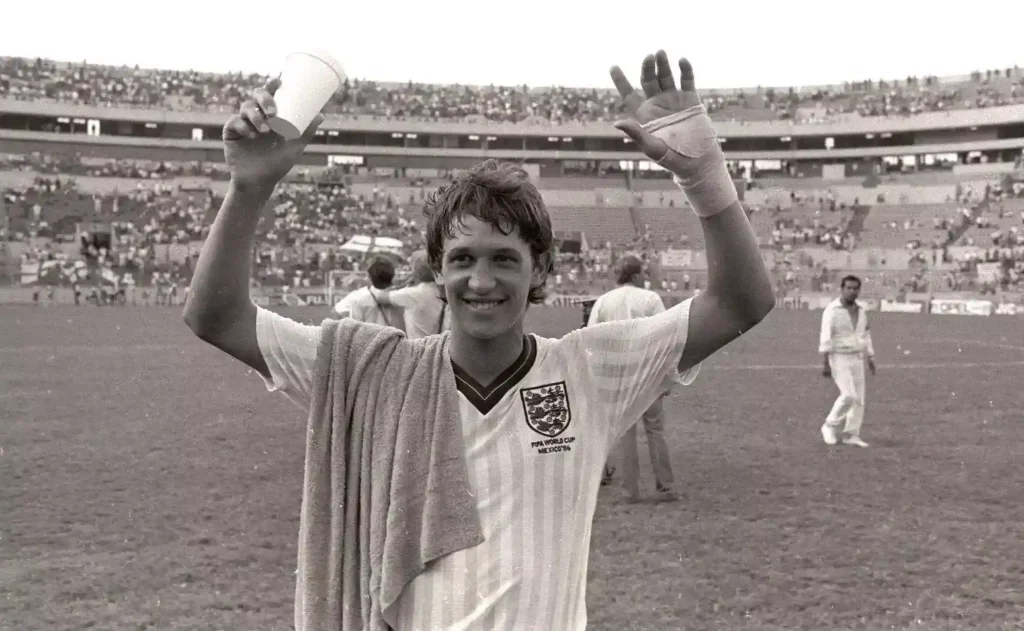
France Were The 1986 World Cup Favorites
Argentina was not the hot favorite. For example, France already had Michel Platini, who had already risen to world fame. England had their best team in a long time, with Gary Lineker, who would finish as the 1986 World Cup tournament’s top scored with six goals.
Traumatized by their defeat in 1982, Brazil still had Zico, Sócrates, Junior, and Falcão. Telê Santana was still the manager, and they wanted to correct what they felt to be an injustice four years earlier.
Italy was the defending champions, and West Germany, coached by Franz Beckenbauer, had Lothar Matthäus, the successor of their legendary sweeper.
There was also room for sensations, such as Michael Laudrup’s Denmark. The Danish won three matches in the group stage. Playing offensive football, they thrashed two-time winners Uruguay 6-1.
A rather good start, as together with Canada and Iraq, this was their first FIFA World Cup.
The Soviet Union, Emilio Butragueño’s Spain, and Belgium also showed a lot of force but ended up eliminated along the way. Morocco, the first African country to ever get through the first stage of the World Cup, after winning their group thanks to a 3-1 win over Portugal. However, Morocco would be eliminated in the next match against West Germany.
The Argentine Genius
Nevertheless, no one was a match for the Argentine number 10. Maradona scored five goals and gave another five assists in Argentina’s 14. In addition, he scored what is considered the best goal in World Cup history and the most famous irregular goal of all time.
Argentina finished the group stage with two victories over Bulgaria and South Korea and a draw against Italy. In the round of 16, they beat their neighbor Uruguay 1-0.
Maradona took it up a notch in the quarter-final. Their opponent was England. It was the first time that both countries would face each other since the Falklands War.
The Argentines took the lead with an irregular goal by Dieguito. He used his hand to lob goalkeeper Peter Shilton. The referee allowed the goal, and then Maradona would dub the goal as the ‘Hand of God.’‘
However, the second goal scored by Argentina’s number 10 against the English was a scorcher. Maradona got the ball in his half, with his back to the opponent’s half. He turned, left the first marker behind, and sprinted towards goal, dribbling past five English players, including keeper Peter Shilton, before tapping the ball into the back of the net.
Lineker managed to pull one back, but Argentina was through to the semi-final, and the French newspaper L’Équipe published a sentence that perhaps best describes Maradona: ‘Half angel, half demon.’
1986 FIFA World Cup Player Of The Tournament
Maradona got another two memorable goals in Argentina’s victory over Belgium in the semi-final, giving their goalkeeper Jean-Marie Pfaff, who had disdained him before the match, something to think about.
In the 1986 World Cup final, there were the Germans again, who, like in 1982, had eliminated Platini’s France in the semi-final. In the final, German manager Franz Beckenbauer gave Lothar Matthäus the responsibility of marking Maradona.
Argentine defender José Luis Brown, who played quite a bit of the match with an injured hand, opened the score. Then, Jorge Valdano increased their lead.
However, the Germans would once more show their incredible recovery capability and draw the match with goals from Karl-Heinz Rummenigge and Rudi Völler. But not even Matthäus managed to stop Maradona. In the 83rd minute, Dieguito released Jorge Burruchaga, who scored Argentina’s third and guaranteed their second title.
Problems From Beginning To End
After mesmerizing the planet in 1982 but coming home early from Sprain, Brazil hoped that things would pan out differently this time, mainly because it still had players like Zico and Sócrates.
However, they faced many problems during the preparation stage. First, manager Telê Santana, who took over a little before the FIFA World Cup, replacing Evaristo de Macedo, cut center forward Renato Gaúcho.
As a result, left-back Leandro decided not to go to the 1986 World Cup tournament in defense of his friend. Injured, Zico had to work very hard to be match fit. To make matters worse, Falcão also had injury problems.
This resulted in narrow victories over Spain and Algeria in the group stage. In the third game, against Northern Ireland, Telê replaced injured Édson with fall-back Josimar.
Brazil And Penalty Shootout
Brazil improved and beat the Irish 3-0, with a goal from Josimar and two from Careca. In the round of 16, Poland posed no threat. Josimar scored again, as did Careca, and Brazil managed an easy 4-0 win.
However, their joy was short-lived. They would play Michel Platini’s France, European champions in the 1986 World Cup quarter-final. Despite this, Brazil took the lead with Careca.
Then Platini equalized in the first half. Finally, in the second half, Zico had the opportunity of sealing the Brazilian win. The Flamengo midfielder got up to take a penalty suffered by Branco.
However, he did not hit the ball well, and French goalkeeper Joël Bats defended. The match went into extra time but remained tied. A penalty shootout was to decide the outcome.
This time, Zico converted his effort. However, Sócrates and Júlio César missed their penalties and watched as the talented 1980s generation bid a sad farewell to the 1986 World Cup.
1986 Soccer Mascot
Juanito, a little boy, was the previous Mexico mascot of the 1970 FIFA World Cup in Mexico. However, this time a different mascot had to be created. As in Spain ’82, FIFA introduced a character related to the host country’s culture. This time it was a jalapeno pepper named Pique.
The jalapeno pepper is a common ingredient in hot Mexican cuisine to create spicy dishes. Pique’s name comes from Picante, Spanish for spicy peppers and sauces.
Pique wears a mustache and the flat part of a sombrero since his head completes the sombrero form. Although Mexico is wearing green shirts, Pique contains a red shirt and white shorts to match Mexico’s colors.
A green shirt would be hard to differentiate. As with other mascots, Pique is shown with a football. As with the latest mascots, the football is not the Azteca but the famous 1970 World Cup match ball Telstar.
1986 World Cup Song
The 1986 song is very different from the 1982 tournament song. Instead of a catchy happy beat, a deep and beautiful English song named A Special Kind of Hero was introduced as the 1986 World Cup song.
British musical theater actress Stephanie Lawrence is the singer who touched many with this beautiful piece of art. Unfortunately, she passed away in 2000. Nevertheless, a Special Kind of Hero is considered one of the best and most memorable World Cup songs ever.
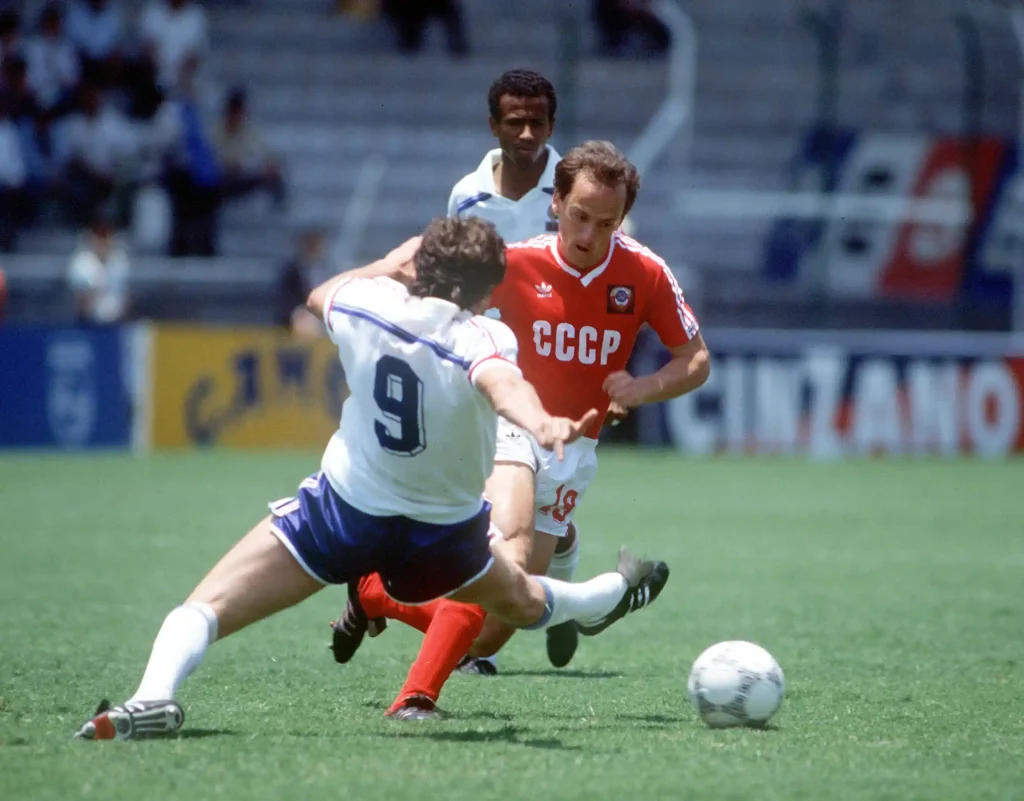
Records Created In The 1986 World Cup
- Three countries qualified for the first time: Denmark, Iraq, and Canada.
- Although Denmark has been a FIFA member since 1904, they couldn’t qualify for any of the previous 12 World Cups.
- The first time the ‘Round of 16’ was played.
- For the first time, the last 2 group matches are played simultaneously.
- Mexico is the first country to have hosted a FIFA World Cup twice.
- Morocco is the first African country to have reached the 2nd round.
- Estadio Azteca is the first stadium to have hosted 2 finals.
- First-time groups are not called by numbers (123456) but by letters (ABCDEF).
- Algeria became the first African country to have twice qualified for a FIFA World Cup.
- Uruguay player Jose Batista was given a red card 56 seconds after the kick-off in the first round match against Scotland, the quickest red card ever in a World Championships.
- Belgium is the first country to have scored all five penalties in a penalty shootout.
- Paraguay’s coach Cayetano Re was the first coach sent off after repeatedly walking on the pitch.
- Argentina player Marcelo Trobbiani played the least amount of minutes on the field in history: only the last two minutes in the Final.
- Although Soviet Union player Igor Belanov scored a hat-trick against Belgium, they lost the match (3-4). This happened once before in history. In 1954, Swiss player Josef Hugi scored a hat-trick against Austria but lost the match (5-7).
- Brazil is the first country to have won the FIFA Fair Play Trophy twice.
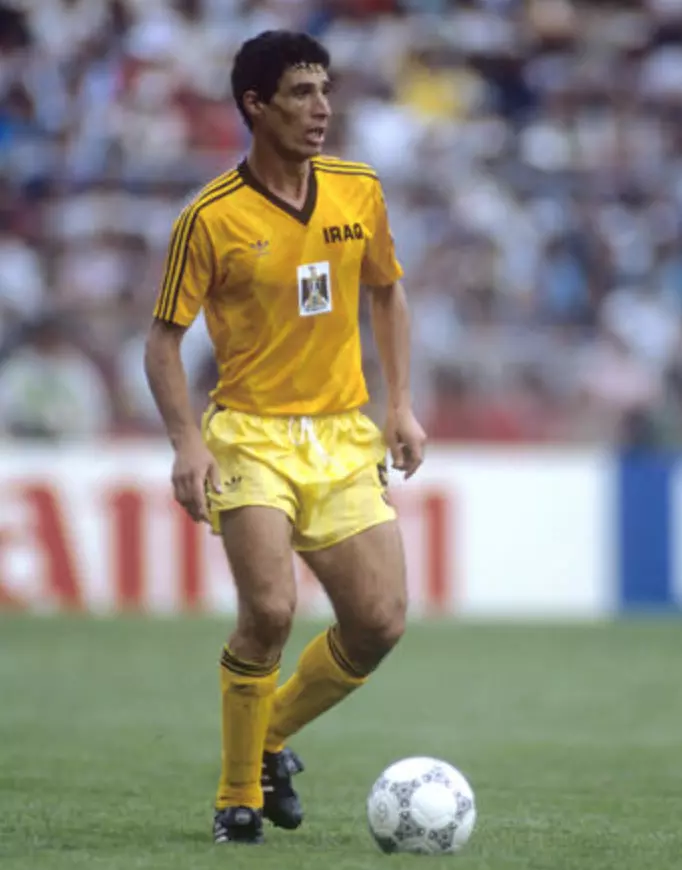
Did You Know
- Italian player Alessandro Altobelli who scored the last 1982 World Cup goal in the Final, scored the opening goal of Mexico ’86 against Bulgaria.
- Argentina became the last country to win a tournament without being a seed country.
- Maradona scored in this World Cup against England a goal with the ‘Hand of God’ and 4 minutes later, a goal that was voted by FIFA.com voters in 2002 the ‘Goal of the Century.’
- Mexico coincidentally reached the Quarter-Finals in the 1970 and 1986 World Cup only: when Mexico was the host country.
- This was the 2nd time Portugal qualified for a FIFA World Cup, twenty years after their first appearance in 1966. It would, however, take at least another sixteen years before Portugal would qualify again (in 2002).
- Iraqi defender Samir Shaker spat at the referee in the match against Belgium. As a result, he received a yellow card and one-year suspension from FIFA and would never play for his country again.
- Portuguese players went on strike over prize money and refused to train between their first and 2nd matches.
- TV announcers were confused during the Round of 16 matches England against Paraguay since there were 2 Gary Stevens on the English side. The two players, Gary Michael Stevens and Gary Andrew Stevens are unrelated.
- Shirt swapping was officially prohibited in 1986 because FIFA did not want players to bare their chests on the field.
- Azteca match ball is the first fully synthetic, waterproof FIFA World Cup ball.
- Azteca match ball was a completely new model made of synthetic material in layers. As a result, no more leather balls were used.
- Azteca match ball is the first that featured a unique design: the triads were based on Aztec murals and architecture referring to the host country.
The first official franchise video game was World Cup Carnival, based on the 1986 tournament. - The Mexican wave appeared for the first time, which became popular worldwide after many people outside North America saw this on the screen, and therefore referred to the phenomenon as Mexican Wave.
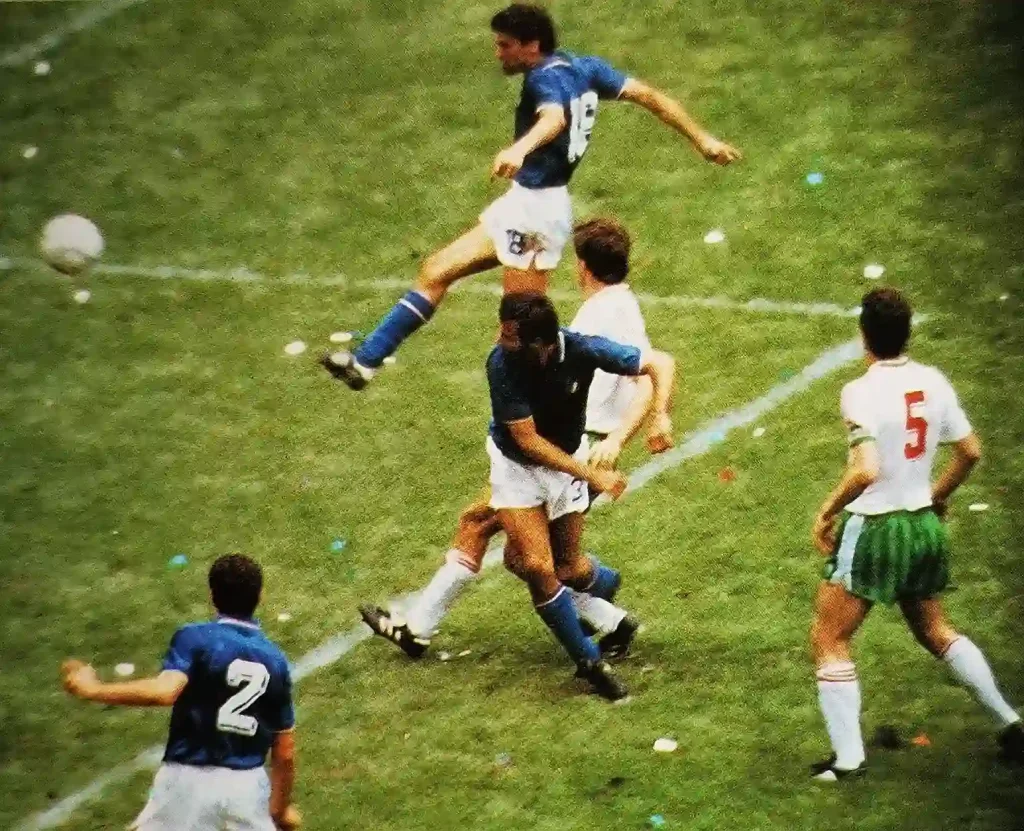
World Cup 1986 FIFA Awards
Golden Ball: Diego Maradona (Argentina)
Silver Ball: Harald Schumacher (West Germany)
Bronze Ball: Preben Elkjær Larsen (Denmark)
Golden Boot: Gary Lineker (England) (6 goals)
Silver Boot: Emilio Butragueño (Spain), Careca (Brazil), Diego Maradona (Maradona) (5 goals)
Bronze Boot: Igor Belanov (Soviet Union), Preben Elkjær Larsen (Denmark), Alessandro Altobelli (Italy), Jorge Valdano (Argentina) (4 goals)
Best Young Player Award: Enzo Scifo (20 years old) (Belgium)
FIFA Fair Play Trophy: Brazil
World Cup 1986 FIFA All-Star Team
Two country’s players are included for the first time: Belgium and Denmark. Only French player Michel Platini has been included before in an All-Star Team.
Argentinian player Diego Maradona made his first appearance on an All-Star Team. This All-Star Team is interesting because of all the Argentinian players who won the 1986 World Cup, only Diego Maradona is included.
Goalkeeper
- Jean-Marie Pfaff (Belgium)
Defenders
- Josimar (Brazil)
- Manuel Amoros (France)
- Julio Cesar (Brazil)
Midfielders
- Jan Ceulemans (Belgium)
- Jean Tigana (France)
- Michel Platini (France)
- Diego Maradona (Argentina)
Forwards
- Preben Elkjær Larsen (Denmark)
- Emilio Butragueno (Spain)
- Gary Lineker (England)
